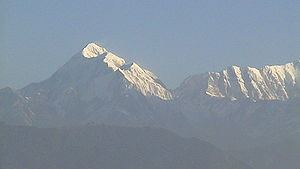Parent range Kumaun Himalaya First ascent 1907 Range Himalayas Listing Ultra-prominent peak | Elevation 7,120 m Prominence 1,616 m First ascender Tom George Longstaff | |
 | ||
Easiest route Northeast flank/north ridge: snow/glacier climb Similar Nanda Devi, Nanda Ghunti, Chaukhamba, Panchchuli, Nanda Kot | ||
Trisul (Hindi: त्रिसूल) is a group of three Himalayan mountain peaks of western Kumaun, with the highest (Trisul I) reaching 7120m. The three peaks resemble a trident - in Hindi/Sanskrit, Trishula, trident, is the weapon of Shiva. The Trishul group forms the southwest corner of the ring of peaks enclosing the Nanda Devi Sanctuary, about 15 kilometres (9 mi) west-southwest of Nanda Devi itself. The main peak, Trisul I, was the first peak over 7,000 m (22,970 ft) to have ever been climbed, in 1907.
Contents
- Map of Trisul Chamoli Uttarakhand 246443
- Description of the massif and neighboring peaks
- Trisul I
- Trisul II and III
- Trivia
- Access
- References
Map of Trisul, Chamoli, Uttarakhand 246443
Description of the massif and neighboring peaks
The three peaks are named Trisul I, Trisul II, and Trisul III. The massif is a north-south ridge, with Trisul I at the north end and Trisul III at the south. The massif runs roughly North-South, and hence appears compressed when viewed from the south (Ranikhet, Kausani), and more stretched out from the Southeast (Chamoli, Bedini Bugyal).
Nanda Ghunti lies a few kilometers to the northwest, while Mrigthuni is just to the southeast.
Trisul I
T. G. Longstaff made the first climbing reconnaissance of Trisul, in September 1905, focussing on the western and southern sides. He returned in 1907 with two other Britons, three Alpine guides, and a number of Gurkhas. They ascended through the Rishiganga valley, to the north of the peak, onto the Trisul Glacier, which lies on the east side. From there they climbed the northeast flank to the north ridge, reaching the summit on 12 June. At the time Trisul was probably the highest mountain to have been climbed. The climb was noted also for the first use of supplementary oxygen in a major climb. During the 1950s Harold Williams led Indian Army expeditions to the summit.
Routes on the west face and south ridge of Trisul I have also been climbed. The west face was first ascended in 1976; this was the first ascent of the main summit not using the first-ascent route.
Trisul II and III
Trisul II and Trisul III were first climbed in 1960 by the Yugoslav team JAHO I. They climbed from the Bidalgwar glacier, achieving the summit of Trisul II via the southern ridge and Trisul III via the north ridge.
Another Yugoslav expedition made the first traverse of the three peaks in 1987, and two members paraglided from the summit.
Trivia
Aleš Kunaver was a member of the first Yugoslav team which climbed Trisul in 1960. In 1987, his daughter Vlasta Kunaver climbed Trisul I and was one of the paragliders.
Access
The Trisul massif can be accessed via the following route: Almora - Kausani - Garur- Gwaldam - Debal - Bagargad - Wan - Bedini Bugyal - Kalu Vinayak - Roopkund - Trisul.
